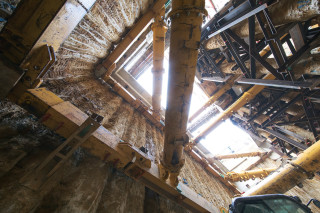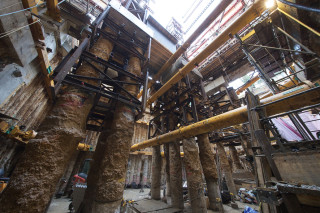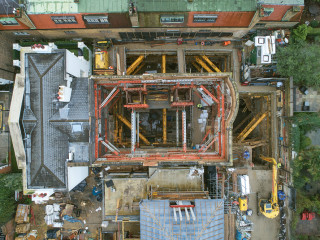There’s nothing especially notable about façade retention projects, especially in London where the need to preserve architectural integrity makes the practice almost routine.
But most façade retentions are essentially straightforward: erect steelwork to support your façade, demolish everything else behind it, build the new structure and tie it into the façade.
But what if you also have to demolish not only everything behind the façade but also everything beneath it?
This was the challenge facing S Walsh & Sons, main contractor on the redevelopment of Amberwood House in Knightsbridge, formerly the Panamanian Embassy and home of legendary ballerina Dame Margo Fonteyn and her ambassador husband Dr Roberto Emilio Arias.
To say Amberwood House is in a prime location is a gross understatement. Its address is 17A Thurloe Place which puts it just over the road from the Victoria & Albert Museum with Harrods and Sloane Street just around the corner.
High-end property developer K10 Group is transforming the three-storey brick mansion into a palatial modern residence extending to 15,300 square feet (1,420 m2) and incorporating a cinema-cum-clubroom and a 12-metre swimming pool – “the largest in Knightsbridge,” according to K10 CEO Kam Babaee. Amberwood House is soon to go on the market at an estimated price of £75m.
Of course to fit all this into the available plot of land, there’s only one way to go, and that is down. Walsh has not merely demolished everything inside the shell of Amberwood House, it has also excavated a 12m-deep, three-storey basement underneath it.
The difficulty is that this basement is not confined within the footprint of the house itself but occupies almost the entire footprint of the site, extending outwards beyond the foundations of the existing house.
“Façade retention isn’t remarkable in London,” confirms Paul McGeady, Walsh’s construction operations manager. “But here we’ve got the façade suspended over our heads. That’s the unusual bit.”
If this were not challenging enough, the site is extremely inaccessible. Amberwood House is tucked away down a private drive – the only way in and out of the site – and is hemmed in on three sides by neighbouring properties. It shares a party wall with one of them, the Grade II-listed Alexander House to the north.
“When it comes to safeguarding neighbouring properties you’ve got to go up a notch,” comments McGeady, somewhat cryptically.
The scheme involves so-called “flying freehold” issues. In other words, Walsh is excavating to create new basement space underneath Alexander House. “The neighbour owns the air above; our client owns the ground below. It’s a peculiarity of London,” says McGeady. “We’ve had to underpin Alexander House and excavate very accurately beneath it. I was about 50mm away from waving at them,” he says.
Walsh has also had to underpin the back walls of four terraced properties in Thurloe Mews, backing onto Amberwood House. “After we’d underpinned them, we installed a secant piled wall just millimetres away from them,” he says.
This pales into insignificance, though, compared with the underpinning and piling work required by Amberwood House itself.
Supporting role
The task of supporting the 12m-deep excavation beneath Amberwood House was entrusted to specialist hirer Groundforce Shorco.
“Deflection criteria were very strict,” says Nadir Salim, the company’s major projects sales engineer. Any significant ground movement was likely not only to cause damage to the retained façades of Amberwood House but potentially also to surrounding buildings.

“On this project, while the propping itself wasn’t too complicated, it was what we were propping and the lack of space in which to work that were the real challenge. The whole project has a very ‘bespoke’ feel to it due to the one-off nature and the extreme physical confines,” he says.
Groundforce supplied a combination of its MP125, MP150 and MP250 modular props (125, 150 and 250 tonnes capacity respectively) and its Mega Brace system to support the secant piled retaining walls.

Due to the lack of space, all equipment had to be lifted and installed using a small excavator. “We therefore had to ensure that all components were within lifting capacities of this digger with nothing weighing more than 2.2 tonnes. This meant splitting the props into small sections where they were assembled at ground level during installation,” says Salim.
The first job was to install reinforced concrete beams under the façades that would be suspended over the excavation. This was done using an “underpin stool methodology” which involved chopping out about 650mm of brickwork every metre or so along the wall and installing steel ‘stools’ to support the masonry above.
“You then remove the rest of the brickwork, install your rebar and cast a continuous beam under the wall. The stools are sacrificial – they stay in the wall,” explains McGeady.
After these areas had been underpinned, Walsh then demolished part of the building to allow piling specialist Van Elle to manoeuvre in a 19-tonne remote-controlled restricted access rig and start installing piled foundations.
Walsh started demolishing the inside of the building while Van Elle installed secant piled walls around the perimeter of the site. As the internal walls came down, steel towers were craned in through the roof opening and positioned behind the façades to support the retention structure. Proprietary bracing was then installed to secure the façades.
Van Elle then came inside the building to install the internal piles, working off a piling mat 4m above cut-off level. “When all the piles had been installed we cast a capping beam and started the excavation,” explains McGeady.
To support the façade directly above the proposed void, Walsh installed cill beams underneath the reinforced concrete beams supporting the walls and transferred the loads onto the piles.
Once the excavation had progressed far enough, specialist hirer Groundforce Shorco installed its proprietary hydraulic props to support the secant piled retaining walls. Additional shoring was installed at each basement level as the excavation progressed.
The final depth to lower basement slab is 12m below ground, though the total depth of the excavation goes down another 3.5m – 4m to accommodate the drainage sumps. By the time Walsh had completed the excavation, the empty shell of Amberwood House was left suspended in mid-air above the yawning void.
Even McGeady’s site office is teetering 12 metres above the excavation on the temporary works – there’s nowhere else on site to put it.
Considering the extreme complexity of the project, it’s tempting to wonder if it’s all worth the bother. Why, for example, go to the trouble of excavating underneath neighbouring properties?
“It’s all about floorspace,” explains McGeady. “Space is worth around £5,000 per square foot in this part of London so developers want as much square-footage as they can get.” Walsh has a target to hit, he adds, and there are penalties in the contract if the finished building comes in below the agreed floorspace.
Unexpectedly poor ground conditions caused more than a few headaches during the early stages of the project, says McGeady. “The ground was so bad…Van Elle lost 15 sets of pile casings,” he says. Several weeks were also lost: Walsh was originally expected to complete its contract just before Christmas; it will now finish this summer.
“We’re on target to have the ground floor slab cast by 15th May. Then we’ll start erecting the new four-storey steel frame inside the building…We’ve got to be watertight by 31st July,” says McGeady.
Although this is later than originally planned, Walsh made impressive progress once the dodgy ground conditions had been overcome. “One and a half months ago, we didn’t even have the sumps excavated; now we’re about to start on the ground floor. Once we start building, we can build very fast.”
It is no exaggeration to say that Amberwood House is a one-off; it is certainly unlikely to be rivalled by anything else locally. In 2015, after planning for Amberwood House had been granted, the London Borough of Kensington & Chelsea introduced new restrictions to curb the proliferation of “iceberg” developments under existing buildings.
New basements under listed properties are now banned altogether.
“Now the local authority has restricted developments to a 4.5m maximum dig. But we’re going down three storeys here,” says McGeady. “This is probably the last three-level basement you’ll ever see in Knightsbridge.”

This article was first published in the April 2019 issue of The Construction Index magazine
UK readers can have their own copy of the magazine, in real paper, posted through their letterbox each month by taking out an annual subscription for just £50 a year. Click for details.
Got a story? Email news@theconstructionindex.co.uk



